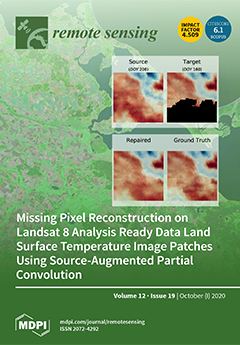Japanese horseradish (wasabi) grows in very specific conditions, and recent environmental climate changes have damaged wasabi production. In addition, the optimal culture methods are not well known, and it is becoming increasingly difficult for incipient farmers to cultivate it. Chlorophyll
a,
b
[...] Read more.
Japanese horseradish (wasabi) grows in very specific conditions, and recent environmental climate changes have damaged wasabi production. In addition, the optimal culture methods are not well known, and it is becoming increasingly difficult for incipient farmers to cultivate it. Chlorophyll
a,
b and carotenoid contents, as well as their allocation, could be an adequate indicator in evaluating its production and environmental stress; thus, developing an in situ method to monitor photosynthetic pigments based on reflectance could be useful for agricultural management. Besides original reflectance (OR), five pre-processing techniques, namely, first derivative reflectance (FDR), continuum-removed (CR), de-trending (DT), multiplicative scatter correction (MSC), and standard normal variate transformation (SNV), were compared to assess the accuracy of the estimation. Furthermore, five machine learning algorithms—random forest (RF), support vector machine (SVM), kernel-based extreme learning machine (KELM), Cubist, and Stochastic Gradient Boosting (SGB)—were considered. To classify the samples under different pH or sulphur ion concentration conditions, the end of the red edge bands was effective for OR, FDR, DT, MSC, and SNV, while a green-peak band was effective for CR. Overall, KELM and Cubist showed high performance and incorporating pre-processing techniques was effective for obtaining estimated values with high accuracy. The best combinations were found to be DT–KELM for chl
a (RPD = 1.511–5.17, RMSE = 1.23–3.62 μg cm
−2) and chl
a:
b (RPD = 0.73–3.17, RMSE = 0.13–0.60); CR–KELM for chl
b (RPD = 1.92–5.06, RMSE = 0.41–1.03 μg cm
−2) and chl
a:car (RPD = 1.31–3.23, RMSE = 0.26–0.50); SNV–Cubist for car (RPD = 1.63–3.32, RMSE = 0.31–1.89 μg cm
−2); and DT–Cubist for chl:car (RPD = 1.53–3.96, RMSE = 0.27–0.74).
Full article





